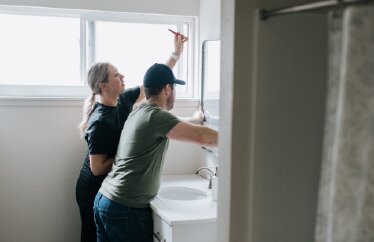The 9 Most Expensive Home Repairs to Watch Out for in 2025

While owning a home is a dream for many, it also means taking on the responsibility of maintenance and repairs. According to our Housepower Report, 46% of surveyed homeowners faced more than $5,000 in unexpected home repair costs in 2024—a significant jump from the 36% reported in our 2023 study.
Repairs can be unavoidable, but they don’t have to catch you off guard. To help you stay proactive and prepared, we've outlined the most expensive home repairs in 2025.*
*These are general homeowner practices, not professional recommendations.
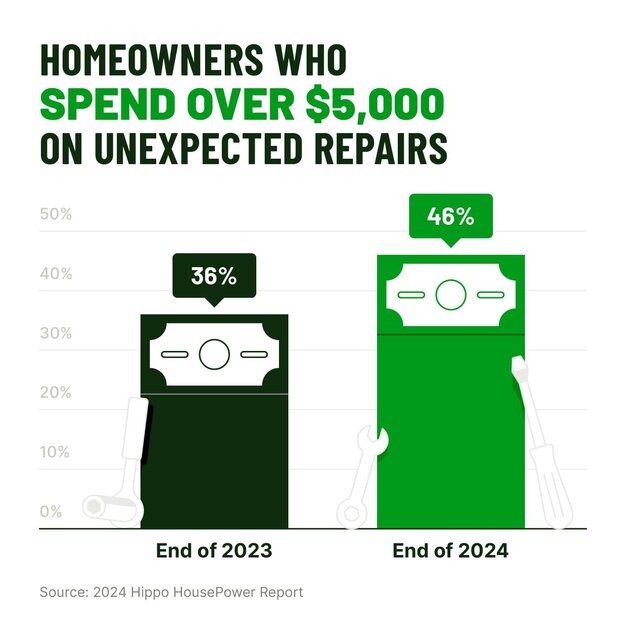
1. Foundations ($2,200 - $30,000+)
- Maintain proper drainage around the home: Clean your gutters regularly, and ensure your downspouts extend far enough away from your foundation (at least 10 feet).
- Address plumbing leaks immediately: Don't delay repairing even the smallest drip. A little leak could cause a big problem underground.
- Monitor for early warning signs: Regularly inspect your home, both inside and out, for any red flags.
- Cracks in walls or ceilings, particularly stair-step patterns, can often be early indicators of foundation issues.
- Doors and windows that stick may suggest shifting frames caused by foundation movement.
- Uneven or sagging floors, including noticeable slopes or soft spots, can signal a settling foundation.
- Persistent or loud house-settling noises may indicate uneven settling beyond normal structural sounds.
2. Roofing ($1,147 - $30,680+)
- Clean gutters regularly to prevent water backup, which can lead to rot along fascia boards and under shingles.
- Trim tree branches away from the roof to keep debris from building up and to help protect your roof from scratches or damage from falling limbs during storms.
- Address minor repairs right away before they get worse. A small, ignored leak could quickly become a big structural issue.
- Schedule professional roof inspections annually, especially after severe weather, to help catch minor damage early.
- Missing, cracked, or curling shingles that show wear, tear, or damage to your roof’s protective layer.
- Granules from shingles that collect in gutters can indicate aging or damage.
- Dark spots or stains on ceilings could signal a water leak and moisture entering your home.
- Visible sagging or uneven areas in the roofline can point to serious structural damage.
3. HVAC systems ($100 - $9,000+)
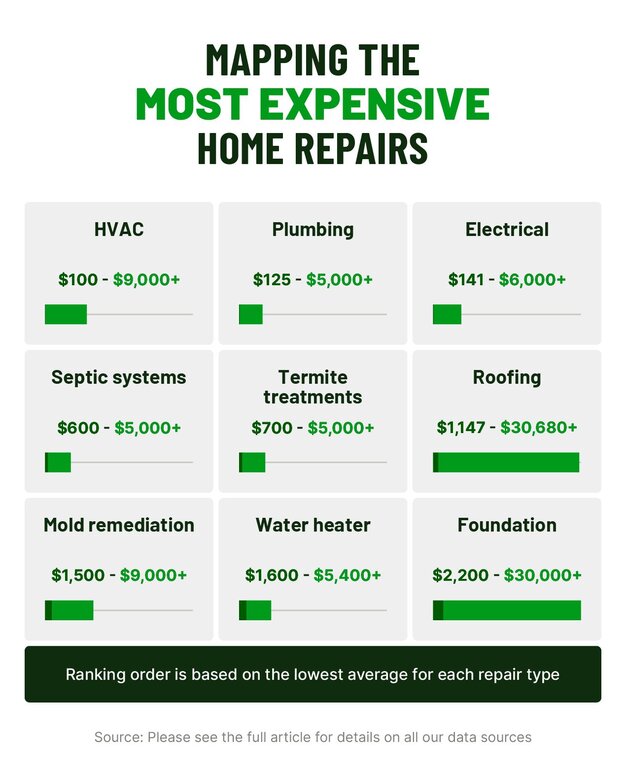
HVAC systems rely on multiple components working in harmony, and any failure can affect your comfort and electric bills. Staying on top of maintenance and noticing early warning signs can help avoid these issues.
General prevention tips:
- Set up regular maintenance schedules (ideally twice a year) with a certified HVAC technician.
- Replace or clean air filters monthly (or as recommended by the manufacturer) to ensure optimal airflow and efficiency.
- Some HVAC experts recommend keeping the home temperature at roughly 68 degrees Fahrenheit in the winter. If that sounds too cold, try increasing the temperature one or two degrees at a time until you find the right balance.
- Keep outdoor AC units clear of debris and ensure proper airflow around them.
- Coverage for HVAC issues can vary by policy and provider. It’s important to review your policy and speak with your licensed insurance producer.
Warning signs to watch for:
- Uneven temperatures in the home or a system that struggles to reach the thermostat setting.
- Unexpected jumps in energy bills without changes in usage or rates.
- Noises such as grinding, squealing, or banging can indicate mechanical problems.
- Weak airflow, which may signal blower motor, duct, or filter issues.
- Unusual odors, including burning, musty, or a “dirty sock” smell, could point to potential electrical problems, mold, or bacterial buildup.
4. Septic systems ($600 - $5,000+)
For homes not connected to city sewer systems, septic system failures can create health hazards and financial burdens. However, according to septic system professionals, there’s something homeowners can do to be better prepared.
"Homeowners consistently miss early warning like slow-draining sinks paired with subtle changes in water taste," explains Mack Blair, owner of Blair & Norris.
With years of experience in well pump and septic system services, Blair knows just how easy it is to overlook signs of trouble.
"I've responded to countless emergency calls where families ignored these signs for months, then suddenly faced complete septic backup during holiday gatherings. That metallic taste in your well water isn't normal—it often signals your pump system is pulling sediment that can contaminate your entire water supply."
On average, homeowners can expect to pay anywhere from $600 to $2,500 for minor septic system repairs like a pump replacement.5 However, if the septic tank needs to be replaced, costs can range from $3,000 to $10,000.6
A full drain field replacement, which is one of the most expensive septic issues, can easily cost $10,000 to $15,000 or more.7 Proactive maintenance is typically your best financial protection.
General prevention tips:
- Avoid flushing non-biodegradable items down toilets. This includes wipes (even "flushable" ones), paper towels, feminine hygiene products, and excessive food scraps.
- Schedule professional inspections and pumping of your septic tank every 3-5 years (or more frequently for larger households or smaller tanks).
- Keep the drain field area clear of heavy objects, vehicles, and planting large trees or shrubs directly over it.
- Conserve water by fixing leaky faucets and toilets, and staggering laundry loads, to avoid overwhelming the system.
- Direct downspouts and sump pump discharge away from the drain field to prevent excess water from saturating the soil and impeding proper drainage.
Warning signs to watch for:
- Sewage backup in drains or toilets can be a clear sign of a major septic problem, indicating a blockage or overflow in the system.
- Strange noises coming from your drains, especially after flushing a toilet, can indicate air trapped in the system due to blockages.
- Standing water or soggy ground near the septic tank or drain field could suggest that wastewater is not properly draining into the ground and is surfacing instead.
- A strong, foul odor of sewage outside your home, particularly near the septic area, or even indoors, can point to a system failure.
- Lush, greener grass over the septic drain field can indicate that wastewater is surfacing or not being properly absorbed.
5. Plumbing ($125 - $5,000+)
Ignoring plumbing issues can cause widespread water damage that leaves a lasting impact on your home. On average, homeowners can expect to pay $125 to $5,000 on plumbing repairs, depending on the severity of the issue.8
For example, things like basic toilet repairs could cost less, while major pipe leak repairs can cost $5,000 or more. Extensive water damage can also cause the need for structural drying, mold remediation, and significant reconstruction, adding to the cost.
General prevention tips:
- Insulate pipes in cold areas (attics, basements, crawl spaces, exterior walls) to help prevent freezing and bursting during winter.
- Watch water pressure levels and consider installing a pressure regulator if your home's water pressure is consistently too high, as this can strain pipes and fixtures.
- Stop leaks immediately, no matter how small. Even a slow drip can cause significant damage over time.
- Regularly inspect exposed pipes for signs of corrosion, drips, or dampness.
- Know where your main water shut-off valve is and how to use it, so you can quickly turn off the water in an emergency.
- Clean gutters and downspouts to ensure proper drainage away from your home's foundation. This can help keep water from seeping into your basement or crawl space.
Warning signs to watch for:
- Sudden increases in water bills can often indicate a hidden leak.
- Musty odors or visible mold growth may signal ongoing moisture problems.
- Reduced water pressure can point to a significant leak in the plumbing system.
- Water stains on ceilings, walls, or floors can show clear signs of water intrusion.
- Dripping sounds when faucets are off may suggest a hidden leak.
6. Electrical systems ($141 - $6,000+)
Electrical system upgrades are expensive but vital. An outdated electrical system where wiring is too thin to safely handle the electrical current (a.k.a. undersized wiring) or lacks sufficient outlets is a major safety risk that may cause fires or appliance damage.
According to HomeGuide, electrical repair costs can vary widely, from $140 for simple fixes like doorbell rewiring to $1,100 or more for panel upgrades.9 Complete home rewires can easily reach $10,000 to $25,000, depending on the home.10
That said, electrical work is generally not considered a DIY job, since it requires licensed electricians who can safely handle high voltage and follow strict codes. Instead, focus on steps like these to help maintain electrical systems and potentially reduce the need for major electrical projects.
General prevention tips:
- Schedule professional electrical inspections every few years, especially for older homes, to find and fix potential hazards before they become major issues.
- Avoid overloading outlets and circuits by distributing high-wattage appliances across different circuits and using power strips with built-in surge protection.
- Upgrade older electrical panels proactively to meet modern energy demands and improve overall safety.
- Install Ground Fault Circuit Interrupters (GFCIs) in bathrooms, kitchens, and outdoor areas to help protect against shock, and Arc Fault Circuit Interrupters (AFCIs) in bedrooms to help prevent electrical fires.
- Be mindful of appliance wattage and make sure your circuits can handle the load.
Warning signs to watch for:
- Frequent circuit breaker trips or blown fuses can indicate overloaded circuits.
- Flickering or dimming lights may suggest inconsistent voltage or an overloaded circuit.
- Outlets that feel warm or show discoloration can signal overheating and potential fire risk.
- Burning smells near outlets or the electrical panel usually require immediate attention.
- Sparking outlets or switches can point to serious wiring problems.
7. Termite treatments ($700 - $5,000+)
Termites are a homeowner's nightmare, silently chewing through wood and causing extensive, often unseen structural damage. An undiscovered colony can eventually lead to weakened timbers, sagging structures, and even collapse.
The high cost of dealing with termites involves not just extermination but a comprehensive approach to both treatment and repairing any significant damage. This is especially important to consider when protecting your home while on vacation, since an undetected infestation can get worse in your absence.
On average, homeowners can expect to pay anywhere from $700 to $5,000 for professional termite removal.11 If there's structural damage, the combined cost of removal and repairs can easily escalate beyond the initial scope.
The damage from a termite infestation often remains hidden until it becomes a major issue that needs extensive repairs to your home’s structure. However, homeowners can take preventive measures to help slow or stop this issue.
General prevention tips:
- Schedule annual termite inspections with a licensed pest control professional, especially if you live in an area prone to termites.
- Eliminate moisture problems around the foundation by ensuring proper drainage, fixing leaky pipes, and keeping crawl spaces dry.
- Remove wood debris and mulch from around the foundation, keeping at least a one-foot gap between soil and any wood parts of your home.
- Repair any cracks in your foundation or exterior walls to seal potential entry points.
- Ensure proper ventilation in basements and crawl spaces to reduce humidity levels.
Warning signs to watch for:
- If you tap on wooden supports and hear a hollow knocking sound, that could indicate that termites have eaten the interior.
- Mud tubes along foundations or wooden structures can show termite travel paths.
- Sagging floors or ceilings point to significant structural damage.
- Piles of discarded wings near windows or lights suggest termite swarmers have been active.
- Small, pellet-like droppings (frass) near wood can signal termite activity.
8. Mold remediation ($1,500 - $9,000+)
Mold is fast-spreading and can threaten both your home and your health. Beyond property damage, mold poses health risks like allergies, breathing issues, and asthma from airborne spores.
Because it spreads so fast and is so severe, professional mold removal is recommended for proper containment, removal, and prevention. On average, affected homeowners could pay $1,500 to $9,000 for professional mold remediation, depending on the size of the affected area and the extent of the damage. Repairs for extensive spreading, major demolition, or HVAC system damage can easily exceed $30,000.12
Once mold has grown in your home, it's harder (sometimes impossible) to remove it yourself. However, there are many steps you can take to help prevent it altogether.
General prevention tips:
- Address water leaks immediately, no matter how small. Fix leaky pipes, dripping faucets, or roof leaks as soon as you notice them.
- Use exhaust fans in bathrooms and kitchens during and after moisture-producing activities (e.g., showering, cooking) to vent humid air outside.
- Regularly inspect areas prone to moisture, such as basements, attics, crawl spaces, and around windows, for any signs of dampness or mold.
- Control indoor humidity by using dehumidifiers in damp areas like basements and ensuring proper ventilation throughout your home.
- Ensure proper drainage around your home's foundation to stop water from seeping into your basement or crawl space.
- Insurance coverage for mold can vary widely depending on the provider and the cause of the damage. Reviewing your policy or checking with your licensed insurance producer is the best way to understand what’s included.
Warning signs to watch for:
- Visible mold growth on walls, ceilings, floors, or any other surfaces. Mold can appear in various colors, including black, green, white, or even orange.
- Persistent musty or earthy odors, even if you can't see visible mold. This smell can be a strong sign of mold in your house.
- Allergic reactions or respiratory issues when indoors, such as sneezing, coughing, watery eyes, skin rashes, or difficulty breathing, especially if symptoms improve when you leave the house.
9. Hot water heaters ($1,600 - $5,400+)
Homeowners could pay $1,600 to $3,500 for a traditional tank-style water heater replacement, including parts and labor.13 However, upgrading to a tankless or heat pump water heater can easily push that cost to $3,000 to $7,000 or more, depending on the complexity of the installation and required system changes.14
While equipment breakdown coverage might offer relief for unexpected appliance failures, taking preventive measures can help you file a smaller claim or none at all.
General prevention tips:
- Schedule annual professional inspections to help catch issues early and ensure optimal performance.
- Check and replace the anode rod as needed (typically every 3-5 years) to prevent tank corrosion.
- Monitor water pressure and temperature settings to reduce extra stress on the system.
- Flush your water heater tank annually to remove sediment buildup, which improves efficiency and extends the unit's life.
- Consider installing a water softener if you live in an area with hard water to minimize mineral buildup.
Warning signs to watch for:
- Popping or rumbling noises and reduced hot water may indicate sediment buildup in the tank.
- Rust around valves, connections, or on the tank itself can signal corrosion and potential tank damage.
- Inconsistent or lukewarm water can point to faulty heating elements or thermostats.
- Puddles or drips around the base of water heaters could point to a leak and require immediate attention.
General tips for saving toward home repairs
Unfortunately, nothing lasts forever. Even the highest quality home systems fail eventually. The question is whether you'll be ready.
“The biggest mistake I see homeowners make is treating home repairs as emergencies instead of planned investments. Emergency replacements can cost 30-40% more than scheduled renovations,” explains Mike Martinez, owner of Accountable Home Services.
When budgeting for home maintenance, here are a few general guidelines to consider:
- Use the 1% rule as your starting point. Save 1-3% of your home's value annually for maintenance. For example (if you’re saving 3%), a $300,000 home would require putting aside $9,000 per year, which comes out to $750 per month.
- Assess your home's condition. Note the age and condition of major systems like your HVAC, water heater, and roof. Schedule a professional inspection to find upcoming needs and set up a repair schedule.
- Prioritize by urgency. Focus savings on systems nearing the end of their expected lifespan or showing problems. Safety-critical items like roofing and electrical work are often prioritized.
- Automate your savings. Set up a separate savings account with automatic monthly transfers to prepare for home repairs.
Don’t let major repairs catch you off guard
Homeowners have the power to make a difference when facing even the most expensive home repairs. Smart financial preparation (like an emergency fund) and proactive maintenance can greatly reduce their impact.
And for repairs that you can't prevent, comprehensive insurance coverage can offer a crucial safety net that protects your investment from financial disaster.
At Hippo Insurance Services, we believe in empowering homeowners to protect their biggest asset. Get in touch with a licensed Hippo agent to explore homeowners insurance and other coverages tailored to your needs.
Sources:
- How much does foundation repair cost? (2025 Pricing)
- How much does it cost to replace a 1,200 sq ft. roof?
- How much does a new roof cost in 2025?
- How much does HVAC repair, service, and maintenance cost? (2025)
- How much does AC replacement cost? (2025)
- 2025 septic tank repair costs
- How much does a septic tank installation cost?
- 2025 leach and drain field replacement costs and repairs
- How much are average plumbing estimates? (2025)
- 2025 electrical work pricing guide
- Cost of rewiring a house: 10 essential facts & savings 2025
- Termite treatment cost: Is it worth it?
- How much does mold remediation cost? (2025 guide)
- Cost to replace a water heater
- How much does it cost to replace a water heater?
- All quotes sourced from Featured.com
This article is for informational purposes only and was compiled from sources not affiliated with Hippo. While we believe this information to be reliable, we do not guarantee its accuracy or completeness. For any insurance-related decision, please consult your licensed insurance producer.

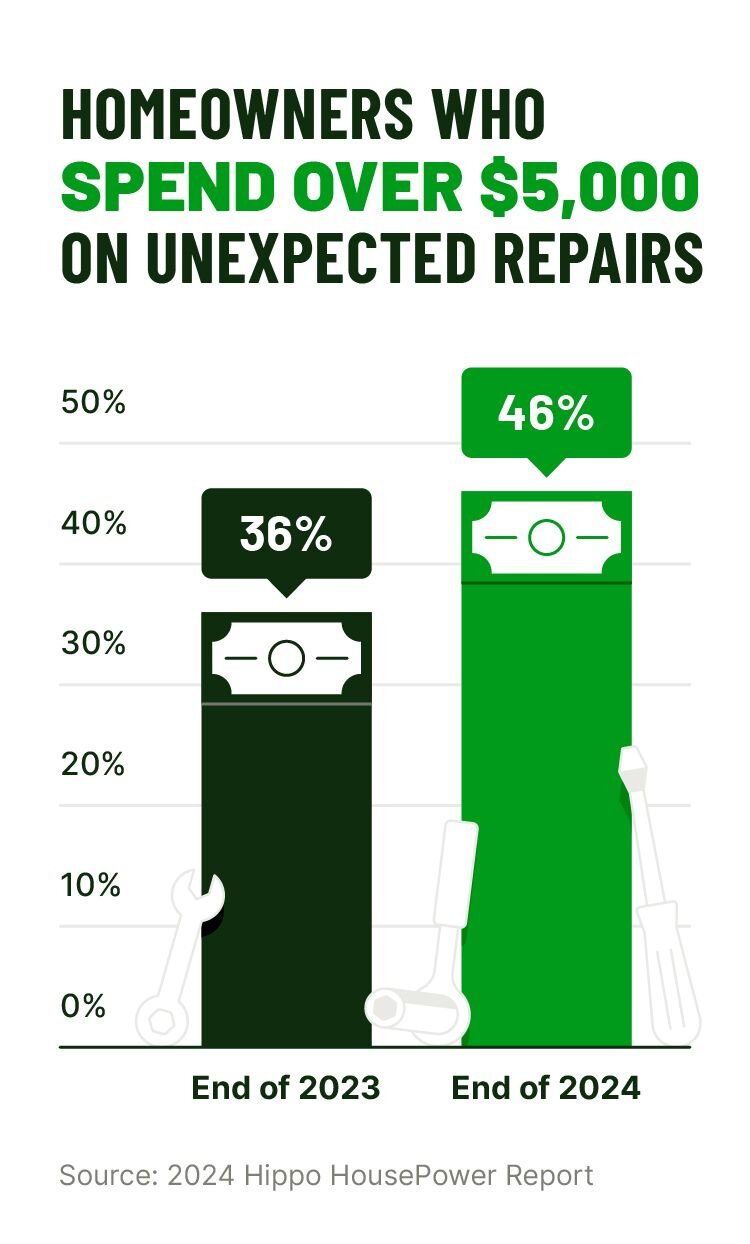
Related Articles
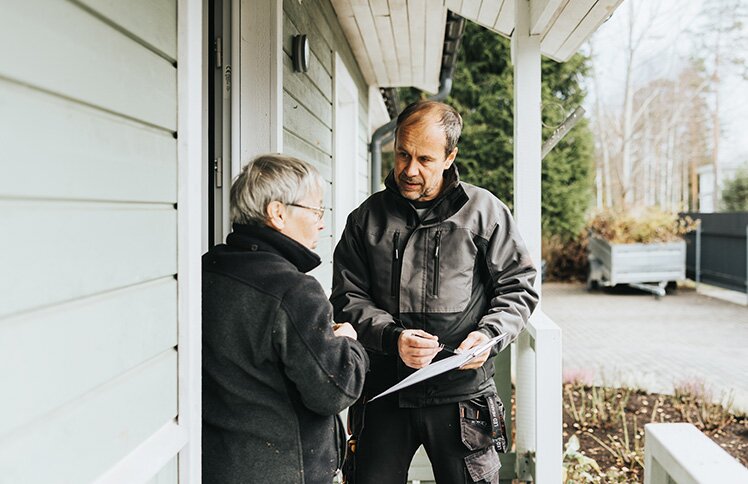
Confronting Home Repair Scams: Experts Weigh In on How To Protect Yourself

Critical Home Maintenance Upgrades: 5 Best ROI Home Improvements in 2024

When Is the Best Time To Buy a House? Expert Tips for Homebuyers
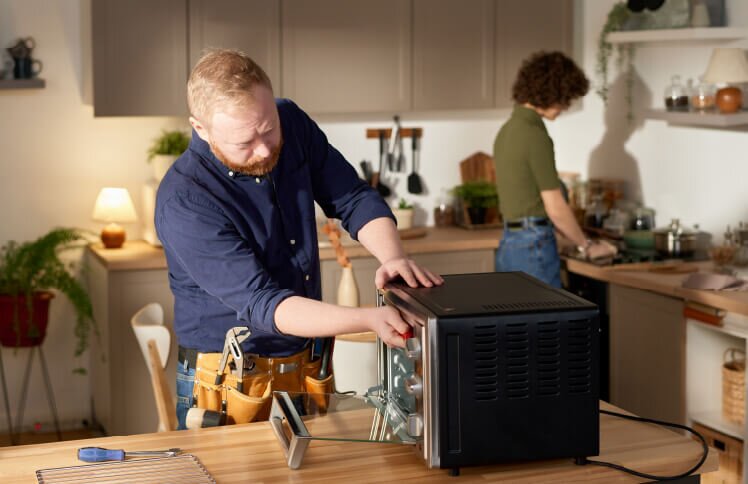
Home Appliance Maintenance Tips To Help You Avoid Summer Meltdowns

Backyard Safety Gap: 66% Overlook Insurance When Installing Outdoor Amenities
